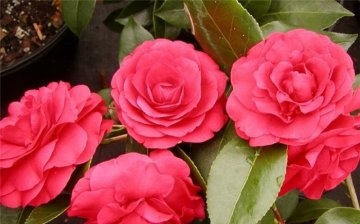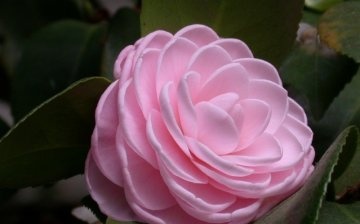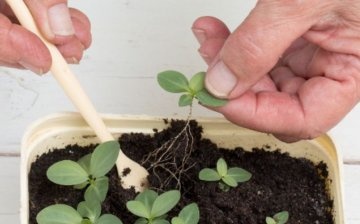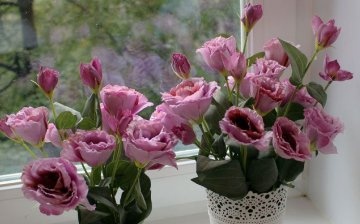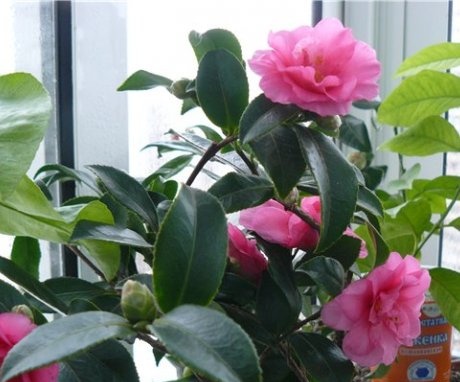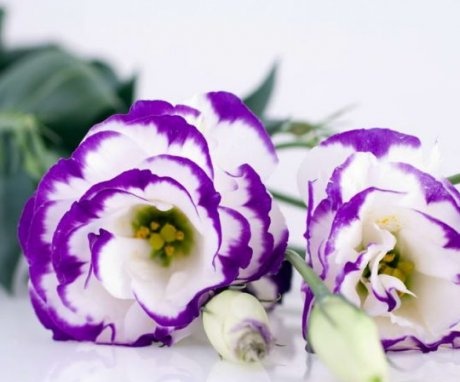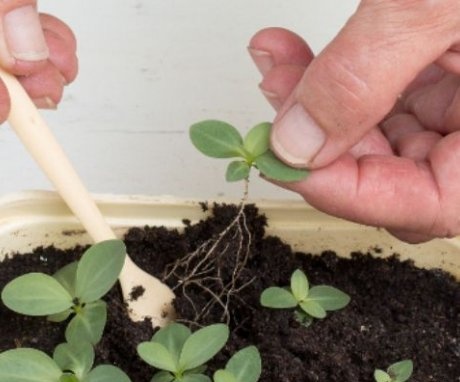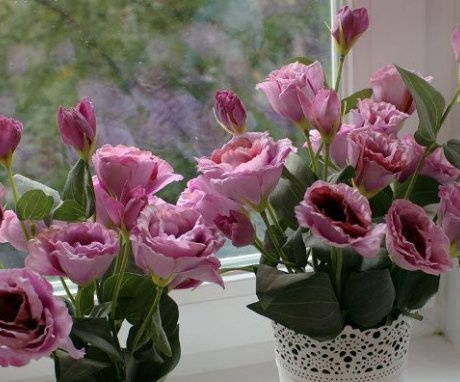Japanese indoor rose: the best varieties and features of their cultivation
Japanese rose, French, Irish, Chinese - as soon as this wonderful plant is not called. In Mexico, it is called the "prairie bell" and can be found in Texas, Nebraska, Colorado and South America. These flowers of extraordinary beauty simply do not give an opportunity to pass by. People loved this wild flower so much that they decided to adapt it to their home conditions.
There are several varieties of indoor plants called the Japanese rose. But the representatives of the species are united by an unusual coloring and grace of forms and colors. The most popular and sophisticated varieties are "Camellia" and "Eustoma».
Content:
- Japanese rose - "Camellia"
- Features of growing and caring for a plant
- Diseases and pests, the fight against them
- Japanese rose - "Eustoma"
- Reproduction methods
- How to properly care for a flower?
Japanese rose - "Camellia"
Japanese rose "Camellia", belonging to the tea family, is distinguished by its special decorativeness and delicate refined flowers. Japan is considered the homeland of the plant, and camellia also grows in nature in China, on the islands of Java and the Philippines. An evergreen shrub plant with dense glossy foliage and beautiful bright roses fits favorably into any interior.
The plant is not picky and, with minimal care, pleases its admirers with the elegance of flowering.
Camellia leaves are dark green in color, have an oval shape. Flowers are simple and double. The color of camellia flowers is very diverse: white, pink, red and even yellow. The petals can be decorated with stripes, spots and streaks of different shapes and colors. Camellia flowers in their shape can resemble a rose, peony, anemone or carnation.
Features of growing and caring for the plant
Camellia is a light-loving plant, but still it does not accept direct sunlight, in the summer it requires shading. For the correct formation of the crown, the flower pot periodically needs to be turned towards the light by the side that needs the branches to grow.
During the flowering period, the rose should not be disturbed, it can drop the already formed buds.
The flower requires regular watering with soft water, but only after the upper part of the soil is completely dry. It is better to drain excess water, since waterlogging is undesirable and can lead to decay root system.
In the process of caring for a plant, it is very important to create the most suitable temperature regime in the room individually for each season:
- in summer, the temperature should not be higher than 22-25 degrees above zero
- in the spring and during the flowering period it is better to maintain the temperature within + 15-17C
- in winter, the temperature regime should be + 10-15C
The rose is transplanted in the usual way: there is drainage at the bottom, oxidized soil on top, always diluted with humus. If it is not diluted, the leaves will turn yellow and may fall off. The capacity should be appropriate for the plant: for a small plant, the pot should also be small.
Camellia is best propagated by cuttings of semi-lignified shoots of the plant in the spring season.After two years, camellia will delight you with exuberant flowering.
It is necessary to transplant and process the flower with gloves, as it is poisonous.
Diseases and pests, the fight against them
A home-grown plant can also get sick, the reason for this is improper care. Rose is often sick:
- cucumber mosaic (the veins of the leaves turn yellow), such a disease is treated insecticides
- fungal diseases (gray spots on foliage), they are eliminated fungicides
- oidium (gray spots throughout the plant) - the leaves are treated with soapy water
If you find any signs of plant disease, you do not need to despair. By choosing the right method of treatment, you can save a home rose from any ailment without much effort.
Japanese rose - "Eustoma"
Indoor Japanese rose, lisianthus or large-flowered eustoma belongs to the flowering plants of the gentian family. In nature, it grows both in lowlands and on river slopes, its homeland is the southern United States, but it is often found in Mexico and the Isthmus of Panama. The height of the plant stretches up to 90 cm, on its branched stem there are large green leaves and purple inflorescences. One bush can bloom with 20 buds, which will bloom alternately and give the impression of a constantly blooming rose.
Modern Japanese breeders are developing many new varieties of eustoma. Now, in addition to the natural purple color, flowers are pink, white, yellow, apricot and even light green. The varieties differ not only in color, but also in the shape of the flower.
Eustoma is the pearl among all types of Japanese roses.
She has thick leaves and large flowers that can reach 8 centimeters in diameter. Flowers come in incredibly beautiful colors: lilac, white with edges of all kinds of shades, pale pink, yellow and greenish. They can be simple and velvety, and one dense branch of a plant, which can reach a height of 80 cm, looks like a whole bouquet, because it has up to 30 flowers.
In a half-open form, the flower has a shape of a full, unusually delicate roses, and after opening it looks more like a poppy. The cut eustoma flower retains its presentation for a long time, therefore, flower growers in many countries of the world are engaged in the cultivation of roses and consider it the best flower for cutting. The rose is so popular that there are more and more varieties of this unusual flower. If earlier plant seeds were available only to professional flower growers, now they can easily be purchased by a simple flower lover.
With a huge variety of roses, plant varieties are divided into two types: tall and short. The first group is used for growing in gardens and greenhouses for commercial purposes, the second for keeping on windowsills. Flowers can be simple and double, of various shapes and colors - there is a rose for every taste.
Reproduction methods
The Japanese rose is propagated by seeds as dividing a bush can lead to a violation of the integrity of the root and subsequently to the death of the entire plant. Cutting of eustomas is contraindicated, since the cut off part of the plant dies without rooting.
As for the seeds, they can be purchased at flower shops or extracted from their already faded buds.
Seed collection is carried out from November to February. The rose blooms after about 20 weeks of germination, from this it follows that the plant planted in spring will delight the owners with its flowering next year.
The seeds can be planted in small plastic cups filled with moist peat soil, sand and a little perlite. 4 seeds are not pressed deeply into each glass, lightly sprinkle and cover with a plastic bag or jar. After a month and a half, the plant dive.
Conditions for the growth of seedlings:
- lighting (bright, diffused)
- watering (only in dry ground)
- pick (after 1-1.5 months)
- feeding (if necessary)
If these conditions are met, the seedlings will sprout and be healthy.
How to properly care for a flower?
You need to plant a room rose in a pot in early March. It is planted in previously prepared containers, that is, pots, the diameter of which does not exceed 8 cm. Eustoma, transplanted into a large pot, will give all its strength to strengthen and grow the root, and to bloom. The pot for transplanting the culture must be filled with drainage and special soil for the given flower (not acidic).
The living conditions for all types of Japanese roses are the same - this is the right lighting, watering and feeding.
Seeds are harvested from a flower in the last months of autumn, when the rose finally fades and seed pods form in place of flowers. Plants of the first and second generation are suitable for collecting seeds, from the third one should not be taken. Unfortunately, not all Japanese rose seeds are highly germinating. For quality assurance, it is better to choose hybrid varieties (F1 markings).
Eustomas growing indoors are less susceptible to diseases, only when overfilled can they be affected by gray rot. For garden plants, lesions by thrips and whiteflies are dangerous. They should be fought with insecticides and fungicides.
More information can be found in the video:
Eustoma indoor pinch the top when it is still a seedling. A biennial plant is pruned to two between nodules before storage. There is no need to be afraid to cut eustoma flowers for a bouquet, it can be produced after several flowers have opened, it will certainly bloom several more times in 4-5 weeks. Pruning even stimulates the meager flowering of garden roses.
Plant and grow a Japanese rose. Of course, it will demand your attention and take a little time, but it's worth it. The unusual beauty and grace of the flower is so mesmerizing that one wants to constantly look at it and admire it. The flower will thank you and your loved ones for their care with beautiful delicate roses.




